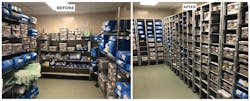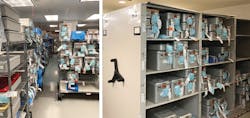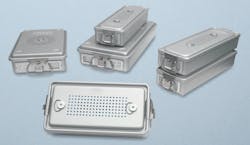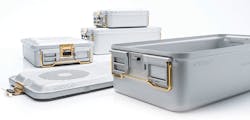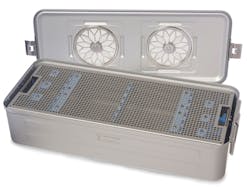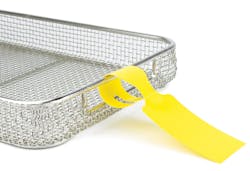Getting surgical instruments squeaky clean and sterilized for the next patient is a meticulous and complicated process. There are many steps to consider — from the transport of dirty instruments from the operating room (OR) to decontamination after a procedure, to the transport of clean and sterile instrument sets back up to the OR for the next case — and everything in between.
The way that central sterile/sterile processing department (CS/SPD) professionals contain and store processed instruments, as well as disposable or “soft goods,” can have a significant impact on process efficiency and safety. In this article, we explore best practices in instrument containment and storage, including commentary from CS/SPD professionals, industry consultants and product/technology manufacturers, as well as new products to help departments achieve their goals.
Storage standards
“Some surveyors are extremely savvy and focused on the storage and transportation of medical devices. They have been known to take out a ruler to ensure that items are stored at least 8” to 10” above the floor. In addition, surveyors have examined the bottom shelf of storage racks and/or transport racks to confirm they are solid, thereby preventing dust and/or other debris from contaminating the medical devices,” said Lane.
Lane says surveyors also have a “very keen eye” when it comes to storage shelves and the distance between the highest item on the shelves and the sprinkler heads above the medical devices. She states: “Facilities get confused from time to time as it relates to the ‘18” rule,’ which is the distance required between the highest items on the top shelf ‘below the ceiling or the level of the sprinkler heads.’”1
She adds that surveyors also tend to scrutinize the sterile storage area. This includes the distance of shelving from the walls, the presence of corrugated cardboard (a potential source of contamination), and the co-mingling of sterile supplies with unsterile supplies.
“Always keep in mind that the shelving should be at least 2” from the outside walls, away from sinks or other pipes, or in any location where it could become wet and/or contaminated,” said Lane. “Additionally, when placing items in the sterile storage area, ensure they are not being stacked in a manner that would cause crushing, or microorganisms or air to enter into the packaging - rendering it unsterile.”
1. AAMI ST79 (2017) 11.1.1 #2
Maximizing limited space
A common challenge faced by many CS/SPDs is the lack of space to store instruments and supplies. Because hospitals historically built and designed their sterile processing space as an afterthought rather than a priority, older departments tend to be small, cramped, dark and housed within the basement.
“Most CS/SPDs across the country experience the same struggles when it comes to storing and transporting instrument sets,” said Ian Loper, Vice President, DSI. “The biggest issue we see falls within the confines of the limited floor space within the four walls of the CS/SPD that the department was originally designed for. The constant increase in surgical procedures in the OR requires an increase in the amount of instrument sets that need to be in stock. For example, a department that was designed to store 600 surgical sets 10 years ago is now storing 1,200 sets to support the increase in procedures.”
“The downstream impact of too much inventory without enough space will negatively impact the department’s freedom of workflow, preference card accuracy, sterility (think tears in blue wraps, cost of reprocessing, cost of rescheduling the patient procedure) employee efficiencies such as searching for the right sets, and overall organization of the department from start to finish,” Loper added. “This is no different than hoarding a lifetime of valuables in your garage and rummaging through it 6) times a day pulling cases without the proper system and equipment in place.”
The 600-bed UCSF Moffitt/Long Hospital in San Francisco is currently engaged in a CS/SPD storage redesign project to implement the Belintra UBeFlex storage system. The hospital is rolling out the project in two phases: Phase one was completed in August 2019 and phase two is slated for completion in October 2019.
Design for efficiency
The way instruments and other supplies in the CS/SPD are contained and stored can have a significant impact on process efficiency. Consider the benefits of a well-organized space where staff members can quickly find what they need versus one that is disordered where staff must search through countless, cluttered supplies to find those items necessary for a case.
In January 2019, Geisinger Community Medical Center (CMC) began a Lean project to redesign its sterile storage area. They have myriad goals: To improve productivity, reduce inventory, streamline workflow by relocating inventory from the hospital’s main distribution, and improve preference card structure to make case picking more efficient.
The idea for the project originated when Manny Rodriguez, Sterile Processing Manager, Geisinger CMC, performed one of his regular GEMBA walks through the department to assess process efficiency and identify areas for improvement.
“While I was observing staff members pick cases I noticed that our sterile storage has instruments on one side and all soft goods/disposables on the other side but there is no rhyme or reason to it,” said Rodriguez. “Every shelf is a number so as they are picking a case there could be something on Z12 and then they go to next item and it is all the way on Z41 — then they have to go back to Z26 - so they are wasting a ton of time.”
Geisinger CMC is redesigning the space so that “like items” are stored in close proximity to each other. For example, instruments and disposable goods for orthopedic cases will all be stored in the same location so when picking a case the CS/SPD staff member has everything he or she needs right at hand.
“It will save time,” said Rodriguez. “If they pick a preference card and it is an ortho case then they go to ortho area and everything will be there. They will no longer have to go from one corner of the room to the other.”
As part of its redesign, the Geisinger CMC team will also be implementing a new shelving system to attain more storage space in its sterile storage area.
“In reality our Lean project cannot succeed if we do not attain more storage space, and there are only a certain number of ways to increase storage in an existing department,” said Toni Amorine, Sterile Processing Supervisor, Geisinger CMC.
Container considerations
Amy Wiedre, Group Marketing Manager, Service Marketing, KARL STORZ-Endoscopy-America, says, “A simple way for a CS/SPD to improve the way it stores and transports surgical instruments is to standardize the sterilization component. We recommend our KARL STORZ no-wrap sterilization containers. No-wrap containers allow for effective sterilization while dramatically reducing the cost and waste associated with traditional blue-wrap sterilization trays. Our containers feature customizable plaques to easily identify contents and thoughtfully designed bases and lids for secure stacking during storage and transportation.”
As Troy Scroggins, Product Manager, Sterile Packaging, Aesculap points out, improperly contained instruments can lead to a number of issues, including holes in wrapped sets that delay cases; missing or wrong instruments (because they are not organized/optimized); dull or broken general and specialty instruments that can lead to higher repair costs and case delays; and inability for the CS/SPD to meet the instrument demands of the OR - timing, right instrument in right/proper condition.
“Rigid containers are a great sterile barrier but in my opinion it’s just as important to consider the tray that goes inside the container,” said Aaron Lieberman, Group Product Manager at Summit Medical, an Innovia Medical Company. “A properly organized and protected instrument tray can positively impact workflow efficiencies and patient safety by allowing instruments to arrive to the OR in optimal working condition and be quickly identified by the technicians.”
Cheron Rojo, Clinical Education Coordinator, Healthmark Industries, AA, CRCST, CIS, CER, CFER, CHL, recommends conducting a risk assessment when evaluating ways to improve the containment process.
“One common way to improve storage of instrumentation/devices is to change the type of container it is contained in,” said Rojo “The way that an item is wrapped or containerized is the number one focus, but really you need to start with the correct type of case before you start looking at wrapped or containerized products. By doing so you can possibly avoid wrap tears, oversized containers, and adding additional storage racks or space. Robotic instrumentation is a great example by moving away from a large case that holds six to eight arms to a case of one to two arms that are highly used and saving the expiration amount of un-used arms.”
Addressing loaner trays
“Loaned instrumentation use is becoming more frequent in facilities,” says Jamie Zarembinski, CCSVP, Sr. Sales Representative, Clinical Educator, Key Surgical. “This increased frequency of instruments and vendors cycling through the department should be managed with a well-planned loaned instrumentation process. Process(es) should be simple and easy to follow in order to effectively execute.”
According to Zarembinski, instrument vendors can help the CS/SPD by color-coding sets using tags when dropping off instruments. She states:
“Require that the vendor capture information about the set using a color-coded tag that also includes date of surgery, specific surgeon or case, time of procedure, and number of trays to help communicate to the team what needs to happen. A simple color-coded tag and a clearly defined process will help enforce compliance by providing a quick visual and set priority and organization.”
Safe transport
Lane says surveyors are looking more and more at the transportation of items, both soiled and clean, within the facility as well as between the facilities. Transportation of contaminated items is commonly one of the areas that surveyors “prey” upon for deviations to what is stated in ST79.
“If a deviation is found, that typically results in multiple questions from the surveyor followed by a recommendation in their findings,” said Lane. “The key to avoiding a surveyor digging into transportation is to ensure that the items are always contained in closed case cart systems, maintenance covers, or other leak-proof containment devices, which are clearly marked as biohazardous or clean.”
“Many times I see facilities that are not covering their carts and identifying their carts or items as bio-hazardous when moved from the surgical area or other clinical areas to the sterile processing department. This is an Occupational Safety and Health Administration (OSHA) requirement and clearly defined in AAMI ST 79 (2017) 6.4,” Lane added. “When this simple step is overlooked, it can trigger a deeper dive by surveyors and typically doesn’t result in a good outcome for the facility as it relates to transporting of contaminated instrumentation.”
About the Author
Kara Nadeau
Senior Contributing Editor
Kara Nadeau is Sterile Processing Editor for Healthcare Purchasing News.


